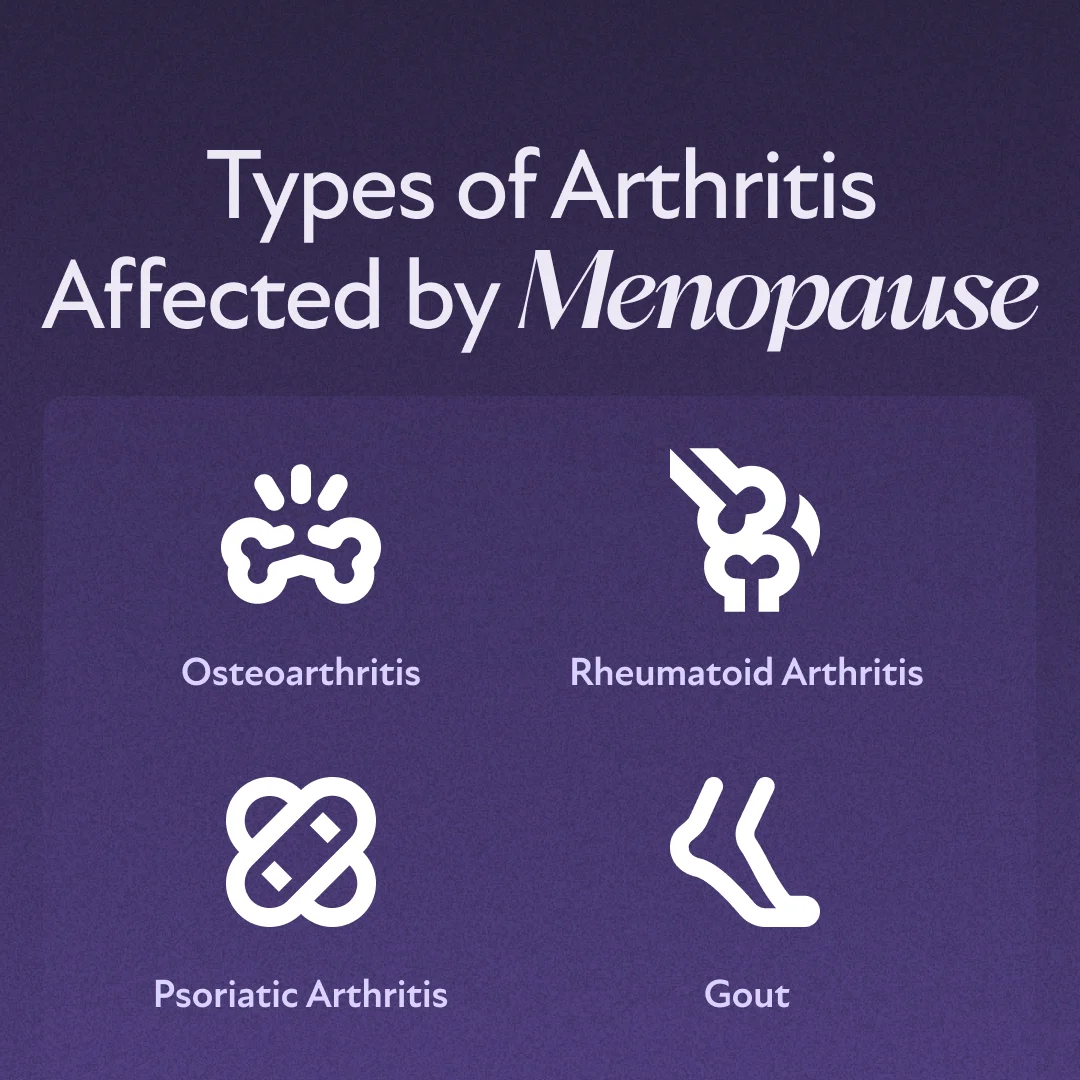Many people believe that arthritis is a natural result of aging. While the condition does predominantly affect older adults, genetics, joint overuse, and various health conditions also play a role. Research findings vary, but hormone fluctuations during menopause may also contribute to the development of arthritis.
Arthritis broadly refers to joint inflammation. However, there are many different types of arthritic conditions, including osteoarthritis, rheumatoid arthritis, psoriatic arthritis, and gout. The progression of osteoarthritis — the most common type of arthritis — is a symptom of what’s known as the musculoskeletal syndrome of menopause. Research suggests that an estimated 25% of women who experience the musculoskeletal syndrome of menopause will be affected by severe symptoms.(1)(2)
Different arthritic conditions vary in their causes and treatment methods. Understanding the potential connection between menopause and arthritis can help women seek effective treatment options to manage symptoms.
The Link Between Menopause and Arthritis
More research is needed to better understand the relationship between menopause and arthritis. However, some studies suggest that women may be at an increased risk for developing arthritic conditions during this phase of life due to hormonal changes. These changes start during perimenopause, or the years leading up to menopause. For some women, menopausal symptoms may persist for as many as 10 years.(2)
During the menopause transition, the body experiences changes in estrogen levels, specifically estradiol (a type of estrogen produced in the body). As a result, women begin to lose lean muscle mass and bone mineral density. Because estradiol suppresses the secretion of inflammatory chemical messengers in the body, a loss of estrogen may increase inflammation. The impact of estrogen deficiency on bone and joint health may subsequently increase women's risk for arthritis.(2)
Hormones That May Cause or Worsen Arthritis During Menopause
For women diagnosed with an arthritic condition, symptoms may worsen during menopause. Just as a decline in estrogen levels may increase the risk of developing arthritis, it may also accelerate the progression of chronic autoimmune diseases, such as rheumatoid arthritis.(2)(3)
Although estrogen is the primary sex steroid hormone in women, progesterone and androgens, including testosterone and dehydroepiandrosterone (DHEA), are also critical for musculoskeletal and immune system health. Progesterone suppresses the body’s immune system response, while DHEA — a precursor to testosterone — helps inhibit the release of pro-inflammatory proteins in the body.(4)(5)
Levels of estrogen, progesterone, and androgens all fluctuate during menopause. These hormonal imbalances may explain the link between menopause and the onset or worsening of different types of arthritis.(5)
Types of Arthritis Affected by Menopause
With over 100 types of arthritis, it’s important to understand the nuances between different arthritic conditions. Some types of arthritis are influenced by wear and tear of the joint, while others are caused by infection or immune system dysfunction. The following are some of the different types of arthritis that may develop during or after menopause:(1)(2)
Osteoarthritis: Osteoarthritis is a degenerative disease with risk factors that include age, sex, genetics, obesity, and joint injury. It’s associated with greater symptom severity in women compared to men. Increases in rates of new osteoarthritis cases are often seen in women during perimenopause and menopause.
Rheumatoid Arthritis: Rheumatoid arthritis is an autoimmune disease that causes stiff, painful joints. In addition to hormone fluctuations, the age of natural menopause may also be a contributing factor. One study showed that the risk of developing rheumatoid arthritis tripled among women who entered menopause before the age of 45 compared to women who entered menopause between the average age of 45 and 55.(6)
Psoriatic Arthritis: Psoriatic arthritis is another autoimmune disease that affects the joints. Most cases occur in individuals with a skin condition called psoriasis. Arthritic symptoms often emerge seven to 10 years after skin symptoms develop.(7) Similar to rheumatoid arthritis, the age of natural menopause may also influence women’s risk for psoriatic arthritis. A study demonstrated that women who entered menopause at a later age were less likely to develop psoriasis and psoriatic arthritis than women who entered menopause before the age of 45.(8)
Gout: Gout is a common type of inflammatory arthritis that causes flares of joint pain, usually in the big toe. It occurs when uric acid crystals form in the joint. While predominantly affecting men, women are more likely to develop the disease after menopause.(9) One study found that the risk of gout increased by 26% in connection with menopause.(10)

Symptoms of Arthritis During Menopause
Symptoms of arthritis may vary depending on the type of arthritic condition. Generally, women may experience the following symptoms of arthritis during menopause:(1)
Joint pain
Stiffness
Swelling
Muscle weakness
Limited mobility
Joint deformities
Arthritic symptoms may also overlap with other common menopausal symptoms:
Muscle aches
Difficulty sleeping
Fatigue
Loss of energy
Changes in mood
Arthritis may affect one joint or multiple joints. It may also impact just one side of the body or both. While osteoarthritis is usually isolated to one side of the body, cases of rheumatoid arthritis are typically symmetrical, often affecting the hands and feet. People with psoriatic arthritis may experience symptoms on one or both sides of the body. Specific joints may also be more prone to symptoms depending on the type of arthritis. In cases of osteoarthritis, the knee, hip, hand, and fingers are commonly affected areas.(1)(2)
Pain severity may also vary throughout the day, depending on the type of arthritis. Osteoarthritis pain is often greater in the evening and exacerbated by physical activity. Rheumatoid arthritis or psoriatic arthritis pain may be felt in the morning as well as when a person is inactive. Unlike osteoarthritis, symptoms may lessen with physical activity but become aggravated with ongoing use.(1)
Treatment Options for Arthritis
Although there is no cure for arthritic conditions, different treatment options may be implemented for symptom management.
Osteoarthritis:
Physical Therapy: Certain exercises and stretches can help relieve pain sensations and increase functioning in the affected joint(s).
Bracing: A supportive brace, commonly used for cases of knee osteoarthritis, can alleviate pressure on the joint, increase stability, and reduce pain.
Weight Management: Weight gain may increase the risk of osteoarthritis. Maintaining a healthy weight with diet and exercise may help reduce symptoms.
Acupuncture: Acupuncture treatment involves the insertion of needles into particular areas of the body. Although research results vary, the traditional Chinese medicine practice may benefit patients with knee osteoarthritis.(11)
Non-Steroidal Anti-Inflammatory Drugs (NSAIDs): Topical or oral NSAID medications may be used to reduce pain and swelling.
Supplements: Study findings are mixed, but ginger, vitamin D, and curcumin (found in turmeric) are a few supplements that may support joint health and help reduce osteoarthritis symptoms.(12)
Steroid Injections: Corticosteroid medication delivered into the joint can decrease pain and inflammation.
Surgery: Because of the potential risks, joint replacement surgery is usually only recommended in the event that other treatment methods prove ineffective.
Rheumatoid Arthritis and Psoriatic Arthritis:
Disease-Modifying Anti-Rheumatic Drugs (DMARDs): These prescription treatment medications hinder the body’s inflammatory immune response and may be used in combination with other anti-inflammatory drugs. It may take weeks or months to see improvement.
Biologics: Biologics are medications that are made from live organisms, including plant cells, bacteria, or yeast. When used in the early stages of the disease, biologics appear to be more effective in treating arthritic autoimmune diseases than NSAIDs or steroid medications.
Gout:
Anti-Inflammatory Medications: Depending on how many joints are affected, NSAIDs, oral steroid medications, or steroid injections may be used to treat gout flare-ups.
Living with Arthritis During Menopause
Arthritis can negatively impact women’s quality of life. Joint pain and limited mobility can make it difficult to perform day-to-day tasks and maintain an active social life. They may even physically limit a person’s ability to work. The following strategies can help menopausal women manage stress associated with arthritic conditions:(13)(14)
Yoga: Yoga has been shown to improve overall health, physical functioning, self-confidence, and vitality in patients with rheumatoid arthritis.
Mindfulness Practices: Practicing mindful awareness and stress reduction techniques may decrease pain symptoms of rheumatoid arthritis.
Meditation: Meditative practices, such as progressive muscle relaxation, may enhance mental health in patients with rheumatoid arthritis.
Professional Mental Health Support: Women experiencing stress or mood changes related to arthritis or menopause may benefit from professional mental health treatment. In-person or online emotional support groups can help patients develop coping skills and foster a sense of community support.
HRT for Arthritis During Menopause
Although hormone replacement therapy (HRT) is not a treatment for arthritis, research shows promise in its ability to reduce musculoskeletal symptoms in menopausal women. Estrogen supplementation has been shown to increase bone mineral density and muscle mass in postmenopausal women.(2) Therefore, the effects of HRT may benefit women with arthritic conditions.
While studies have produced conflicting results, HRT may reduce the risk of osteoarthritis in postmenopausal women.(2) It may also lower the risk of gout. One study found that women who used HRT during postmenopause were 18% less likely to develop the condition.(10) In comparison, some studies indicate that HRT may increase the risk of arthritic conditions.(15)(16) Although more research is needed, guidelines from the American College of Rheumatology (ACR) state that HRT is recommended for the treatment of hot flashes and night sweats in postmenopausal women with rheumatic disease as long as they are not diagnosed with other specific health conditions.(17)
Women experiencing joint symptoms should consult a doctor to determine if HRT may be recommended. Inflammatory arthritis may be associated with other autoimmune disorders, including inflammatory bowel disease (IBD) and celiac disease, so it’s important to speak with a healthcare provider to determine the cause of joint inflammation.(1)
Arthritic symptom management often requires a multipronged approach with the help of primary care physicians, physical therapists, rheumatologists, or dietitians. Women may also benefit from having a menopause specialist on their healthcare team to develop a holistic treatment plan for both arthritic and menopausal symptoms.
Struggling with arthritis during menopause? Discover if HRT is right for you.
If you’ve entered the menopause transition and are dealing with painful arthritis, you’re not alone. Take our brief menopause quiz to see if you’re an eligible candidate for HRT. Get started with Winona to take the first step toward feeling better.
